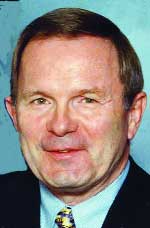A strategic approach to revenue growth

My last column outlined six challenges that can hamper organic and strategic revenue growth in your organization. In this column, I have identified seven key concepts to facilitate the shift from an independent federation - or stovepipe - business development model to a strategic growth model.
My last column ( April 21) outlined six challenges that can hamper organic and strategic revenue growth in your organization. One or two may not limit growth, but more than that should signal the possibility of storm clouds on the horizon.I have identified seven key concepts to facilitate the shift from an independent federation - or stovepipe - business development model to a strategic growth model. You likely are familiar with some of these recommendations and realize you should be embracing them, but other prescriptions might require more reflective thought. Any corporate-led revisions to the federation culture and structure can meet fairly strong resistance. To reap the rewards of the strategic model, you will need to persevere to gain support from the stovepipe and its people. First, seriously consider having an outsider perform a present-state assessment of the business development capability of your sectors, groups or divisions. Is there a singular, cohesive and unified business development planning process? Do the plans include unified objectives? Do the operational and tactical business development plans provide any synergy of resources? Are these plans primarily focused on organic growth? What percentage is focused on strategic growth? Try to gather an understanding of where the business development strategy really exists. Is it corporate- or federation-led?Second, establish a strategic business development function led by a senior or executive vice president reporting to the president and chief executive officer. This person will be responsible for strategic revenue growth. It will be crucial to have a clear position analysis and job description for this role. This person's primary function is to develop the strategic pipeline through the efforts of others on the business development team. Additionally, this person will have direct responsibility for recruiting, mentoring, coaching and developing strategic business development leaders. Third, take a hard look at your step review process to determine how opportunities are identified and qualified. This is, in essence, an audit of the strategic and tactical organic business development process. This review is an early test to determine whether the right opportunities have been identified, qualified and positioned. Another function of the review is to audit and support the strategic revenue growth goals and assure that all resources are allocated to qualified opportunities with the greatest likelihood of revenue growth.Fourth, business development revenue generation needs to be instilled as a bottom-up process that stimulates revenue growth throughout the organization. Anyone in the company who interacts with potential or existing clients needs to understand that they have a business development role. An integrated culture needs to be established to assure that the right individuals are identified to carry out these responsibilities and they receive the necessary training. It is essential that this business development message be communicated across divisions or sectors and joint, collaborative opportunities are identified. By putting a bottom-up business development culture into effect, no group is vulnerable to the departure of business development leadership or team members.Fifth, it's critical to identify and institutionalize a tailored business development curriculum that is centered on opportunity identification and qualification and married to the capture and proposal process. This facilitates strategic and organic growth by unifying strategic business development leaders with others in the company's business units tasked with growing organic business. The sixth objective is a vital component that few companies focus on - the capture of client intelligence in a customer relationship management application. Each call your business development team makes, each piece of data gathered about a client and all action items and commitments made to a client must be recorded. This data is a critical company asset that you risk losing forever because of normal staff turnover if it is not recorded in a central repository. A great question to ask is: "If my business development people died in the night, would I know where all the data is for each of the opportunities they were working on?" If the answer is no, your business development players are probably building an impressive Rolodex that can be shopped to the highest bidder. When they leave, they will take all the client relationships and intelligence with them. These relationships and data are key company assets and must be treated as such. The seventh and last consideration lies in identifying business development talent and leadership in the organization. Some of the best business development leaders emerge from the ranks of program managers, division managers and other employees responsible for assuring that client challenges and problems are resolved. Valuing this innate talent base, fostering its growth in the thinking and execution of business development, providing leadership possibilities and opportunities for mentoring and coaching others on the team assures long-term strategic growth along with continuing, annual organic growth.Understanding and implementing these seven concepts will provide the framework for success. It's then a matter of instilling a business development culture throughout your organization. This means ensuring you have a business development team capable of building long-term relationships, invested in partnering with your clients and passionate about providing clients the best solutions to their problems - even if those solutions are not offered by your company.
 "Find the structure to fuel revenue growth,"
"Find the structure to fuel revenue growth,"
Bill Scheessele (bill.scheessele@mbdi.com) is chairman and chief executive officer at MBDi, an international business development professional services firm.

Bill Scheessele (bill.scheessele@mbdi.com) is chairman and chief executive officer at MBDi, an international business development professional services firm.
NEXT STORY: Compiled Logic buys DTS

